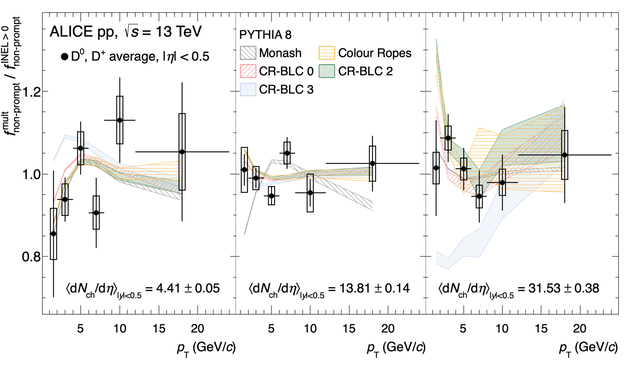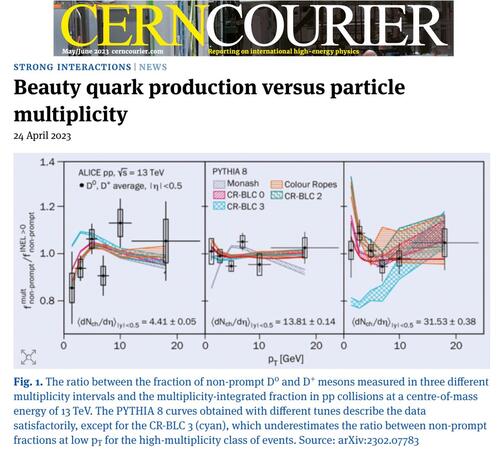
Ratio between the fraction of non-prompt D0 and D+ mesons measured in different multiplicity intervals and the multiplicity-integrated fraction in pp collisions at a centre-of-mass energy of 13 TeV.
Article in CERN Courier Energy Frontier (May/June 2023)
Measurements of the production of hadrons containing heavy quarks (i.e., charm or beauty quarks) in proton–proton (pp) collisions provide an important test of the accuracy of perturbative quantum chromodynamics (pQCD) calculations. The production of heavy quarks occurs in initial hard scatterings of quarks and gluons, whereas the production of light quarks in the underlying event is dominated by soft processes. Thus, the measurement of heavy-quark hadron production as a function of the charged-particle multiplicity provides insights into the interplay between soft and hard mechanisms of particle production.
The measurements in high-multiplicity pp collisions have shown features that resemble those associated with the formation of quark–gluon plasma in heavy-ion collisions, such as the enhancement of production of particles with strangeness content and the modification of the baryon-to-meson production ratio as a function of transverse momentum (pT). These effects can to a large extent be explained by two different types of models: statistical hadronisation models, which evaluate the population of hadron states according to statistical weights governed by the masses of the hadrons and a universal temperature, or models that include hadronisation via coalescence (or recombination) of quarks and gluons which are close in phase space. Both of these models also predict an enhancement of the baryon-to-meson and strange-to-non-strange hadron ratios as a function of the charged-particle multiplicity.
In the charm sector, the ALICE Collaboration has recently observed a multiplicity dependence of the pT-differential Λc+/D0 ratio, smoothly evolving from pp to lead–lead collisions, while no dependence was observed for the Ds+-meson production yield compared to the one of the D0 meson [for details, see arXiv:2111.11948]. Measurements of these phenomena in the beauty sector are needed to shed further light on the hadronization mechanism.
In order to investigate beauty-quark production as a function of multiplicity and to put it in relation with the one of charm quarks, the ALICE experiment measured for the first time the fraction of D0 and D+ originating from beauty hadron decays (denoted as non-prompt) as a function of transverse momentum and charged-particle multiplicity in pp collisions at a centre-of-mass energy of 13 TeV, using the sample of data collected during LHC Run 2. This measurement was performed by exploiting the different decay-vertex topologies of prompt and non-prompt D mesons with machine-learning classification techniques. The fractions of non-prompt D mesons were observed to somewhat increase with pT from about 5% to 10%, as expected by pQCD calculations (see above figure). Similar fractions were measured in different charged-particle multiplicity intervals, suggesting either no or only a mild multiplicity dependence. This finding suggests a similar production mechanism of charm and beauty quarks as a function of multiplicity.
The possible influence of the hadronisation mechanism was investigated by comparing the measured D-meson non-prompt fractions with predictions based on Monte Carlo generators such as PYTHIA 8. A good agreement was observed with different PYTHIA tunes, with and without the inclusion of the colour-reconnection mechanism beyond the leading colour approximation (CR-BLC), which was introduced to describe the production of charm baryons in pp collisions. The only exception was found for the CR-BLC “Mode 3” tune that predicts an increase (decrease) of hadronisation in baryons for beauty (charm) quarks at high multiplicity, which is then disfavoured by the current data.
The measurements of non-prompt D0 and D+ mesons represent an important test of production and hadronisation models in the charm and beauty sectors, and they pave the way for future measurements of exclusive reconstructed beauty hadrons in pp collisions as a function of the charged-particle multiplicity.
The figure shows the ratio between the fraction of non-prompt D0 and D+ mesons measured in different multiplicity intervals and the multiplicity-integrated fraction in pp collisions at a centre-of-mass energy of 13 TeV. The PYTHIA 8 curves obtained with different tunes describe the data satisfactorily, except for the CR-BLC Mode 3 one, which underestimates the ratio between non-prompt fractions at low pT for the high-multiplicity class of events.
Further reading
ALICE Collab. arXiv:2302.07783

